Influences of Spatial Accessibility and Service Capacity on the Utilization of Elderly-Care Facilities: A Case Study of the Main Urban Area of Chongqing
Abstract
1. Introduction
- What are the characteristics of the spatial distribution of ECF utilization, accessibility, and service capacity? In what areas do they exhibit significant imbalances?
- What are the main sources of the overall imbalance in the utilization of ECFs?
- How do accessibility and service capacity impact ECF utilization? What is the extent of the impact?
2. Materials and Methodology
2.1. Study Area
2.2. Data Sources and Preprocessing
2.2.1. Elderly Population Data
2.2.2. Elderly-Care Facilities Data
2.2.3. Network Data
2.3. Accessibility Calculation
2.4. Inequity Calculation
2.5. Regression Model
3. Results
3.1. Spatial Accessibility of Elderly-Care Facilities by Travel Mode
3.1.1. Spatial Accessibility Distribution Characteristics
3.1.2. Decomposition of Regional Accessibility Differences
3.2. Service Capacity and Utilization Rate of Elderly-Care Facilities
3.2.1. Spatial Distribution Characteristics
3.2.2. Decomposition of Regional Differences
3.3. Impact of Accessibility and Service Capacity on the Utilization
4. Discussion
4.1. Principal Findings and Comparison with Other Studies
4.2. Limitations
4.3. Implications
5. Conclusions
Author Contributions
Funding
Institutional Review Board Statement
Informed Consent Statement
Data Availability Statement
Acknowledgments
Conflicts of Interest
References
- Bloom, D.E.; Chatterji, S.; Kowal, P.; Lloyd-Sherlock, P.; Mckee, M.; Rechel, B.; Rosenberg, L.; Smith, J.P. Macroeconomic Implications of Population Ageing and Selected Policy Responses. Lancet 2015, 385, 649–657. [Google Scholar] [CrossRef] [PubMed]
- Zhang, Y.; Cao, M.; Cheng, L.; Gao, X.; De Vos, J. Exploring the Temporal Variations in Accessibility to Health Services for Older Adults: A Case Study in Greater London. J. Transp. Health 2022, 24, 101334. [Google Scholar] [CrossRef]
- Cheng, T.; Liu, C.; Yang, H.; Wang, N.; Liu, Y. From Service Capacity to Spatial Equity: Exploring a Multi-Stage Decision-Making Approach for Optimizing Elderly-Care Facility Distribution in the City Centre of Tianjin, China. Sustain. Cities Soc. 2022, 85, 104076. [Google Scholar] [CrossRef]
- Liu, L.; Lyu, H.; Zhao, Y.; Zhou, D. An Improved Two-Step Floating Catchment Area (2SFCA) Method for Measuring Spatial Accessibility to Elderly Care Facilities in Xi’an, China. Int. J. Environ. Res. Public Health 2022, 19, 11465. [Google Scholar] [CrossRef] [PubMed]
- Zhao, Y.; Smith, J.P.; Strauss, J. Can China Age Healthily? Lancet 2014, 384, 723–724. [Google Scholar] [CrossRef]
- National Bureau of Statistics of China Key Data from the 7th National Census. Available online: http://www.stats.gov.cn/tjsj/zxfb/202105/t20210510_1817176.html (accessed on 16 October 2022).
- China Development Research Foundation China Development Report. 2020. Available online: https://www.cdrf.org.cn/llhyjcg/5787.htm (accessed on 16 October 2022).
- Lu, J.; Liu, Q. Four Decades of Studies on Population Aging in China. Chin. Popul. Dev. Stud. 2019, 3, 24–36. [Google Scholar] [CrossRef]
- Liu, H.; Chen, B.; Li, Y.; Morrow-Howell, N. Neighborhood Resources Associated with Frailty Trajectories over Time among Community-Dwelling Older Adults in China. Health Place 2022, 74, 102738. [Google Scholar] [CrossRef]
- Song, S.; Wang, D.; Zhu, W.; Wang, C. Study on the Spatial Configuration of Nursing Homes for the Elderly People in Shanghai: Based on Their Choice Preference. Technol. Forecast. Soc. Chang. 2020, 152, 119859. [Google Scholar] [CrossRef]
- Ministry of Civil Affairs of the People’s Republic of China. The Historical Context of the 70 Year Development of Pension Ser-Vices in New China. Available online: https://mzzt.mca.gov.cn/article/zt_zl70n/zhbd/201909/20190900020005.shtml (accessed on 16 October 2022).
- Cheng, Y.; Wang, J.; Rosenberg, M.W. Spatial Access to Residential Care Resources in Beijing, China. Int. J. Health Geogr. 2012, 11, 32. [Google Scholar] [CrossRef]
- Cheng, L.; Yang, M.; De Vos, J.; Witlox, F. Examining Geographical Accessibility to Multi-Tier Hospital Care Services for the Elderly: A Focus on Spatial Equity. J. Transp. Health 2020, 19, 100926. [Google Scholar] [CrossRef]
- Ministry of Civil Affairs of the People’s Republic of China. The 14th Five-Year Plan for the Development of the National Ageing Programme and the Elderly Service System. Available online: https://www.mca.gov.cn/article/xw/mtbd/202202/20220200039833.shtml (accessed on 16 October 2022).
- Qi, Z.; Lim, S.; Rashidi, T. Assessment of Transport Equity to Central Business District (CBD) in Sydney, Australia. Transp. Lett. 2020, 12, 246–256. [Google Scholar] [CrossRef]
- Zhao, P.; Li, S.; Liu, D. Unequable Spatial Accessibility to Hospitals in Developing Megacities: New Evidence from Beijing. Health Place 2020, 65, 102406. [Google Scholar] [CrossRef] [PubMed]
- Yang, C.; Tang, X.; Yang, L. Spatially Varying Associations between the Built Environment and Older Adults’ Propensity to Walk. Front. Public Health 2022, 10, 1003791. [Google Scholar] [CrossRef]
- Sharma, G.; Patil, G.R. Public Transit Accessibility Approach to Understand the Equity for Public Healthcare Services: A Case Study of Greater Mumbai. J. Transp. Geogr. 2021, 94, 103123. [Google Scholar] [CrossRef]
- Ogryzek, M.; Podawca, K.; Cienciała, A. Geospatial Tools in the Analyses of Land Use in the Perspective of the Accessibility of Selected Educational Services in Poland. Land Use Policy 2022, 122, 106373. [Google Scholar] [CrossRef]
- Benevenuto, R.; Caulfield, B. Measuring Access to Urban Centres in Rural Northeast Brazil: A Spatial Accessibility Poverty Index. J. Transp. Geogr. 2020, 82, 102553. [Google Scholar] [CrossRef]
- Chang, Z.; Chen, J.; Li, W.; Li, X. Public Transportation and the Spatial Inequality of Urban Park Accessibility: New Evidence from Hong Kong. Transp. Res. Part D Transp. Environ. 2019, 76, 111–122. [Google Scholar] [CrossRef]
- Zhang, F.; Li, D.; Ahrentzen, S.; Zhang, J. Assessing Spatial Disparities of Accessibility to Community-Based Service Resources for Chinese Older Adults Based on Travel Behavior: A City-Wide Study of Nanjing, China. Habitat Int. 2019, 88, 101984. [Google Scholar] [CrossRef]
- Wang, F.; Luo, W. Assessing Spatial and Nonspatial Factors for Healthcare Access: Towards an Integrated Approach to Defining Health Professional Shortage Areas. Health Place 2005, 11, 131–146. [Google Scholar] [CrossRef]
- Huang, Y.; Meyer, P.; Jin, L. Spatial Access to Health Care and Elderly Ambulatory Care Sensitive Hospitalizations. Public Health 2019, 169, 76–83. [Google Scholar] [CrossRef]
- Kim, Y.; Byon, Y.-J.; Yeo, H. Enhancing Healthcare Accessibility Measurements Using GIS: A Case Study in Seoul, Korea (Vol 13, E0193013, 2018). PLoS ONE 2018, 13, e0194849. [Google Scholar] [CrossRef]
- Langford, M.; Higgs, G.; Fry, R. Multi-Modal Two-Step Floating Catchment Area Analysis of Primary Health Care Accessibility. Health Place 2016, 38, 70–81. [Google Scholar] [CrossRef] [PubMed]
- Luo, J. Integrating the Huff Model and Floating Catchment Area Methods to Analyze Spatial Access to Healthcare Services. Trans. GIS 2014, 18, 436–448. [Google Scholar] [CrossRef]
- Everett, T.J.; Everett, B.M. Justice and Gini Coefficients. Politics Philos. Econ. 2015, 14, 187–208. [Google Scholar] [CrossRef]
- Gori, S. Equity Measures for the Identification of Public Transport Needs (Vol 3, Pg 745, 2020). Case Stud. Transp. Policy 2021, 9, 384. [Google Scholar]
- Delbosc, A.; Currie, G. Using Lorenz Curves to Assess Public Transport Equity. J. Transp. Geogr. 2011, 19, 1252–1259. [Google Scholar] [CrossRef]
- Xiao, Y.; Wang, Z.; Li, Z.; Tang, Z. An Assessment of Urban Park Access in Shanghai—Implications for the Social Equity in Urban China. Landsc. Urban Plan. 2017, 157, 383–393. [Google Scholar] [CrossRef]
- Mishra, S.; Sahu, P.K.; Sarkar, A.K.; Mehran, B.; Sharma, S. Geo-Spatial Site Suitability Analysis for Development of Health Care Units in Rural India: Effects on Habitation Accessibility, Facility Utilization and Zonal Equity in Facility Distribution. J. Transp. Geogr. 2019, 78, 135–149. [Google Scholar] [CrossRef]
- Yuan, J.; Li, L.; Wang, E.; Skibniewski, M.J. Examining Sustainability Indicators of Space Management in Elderly Facilities—A Case Study in China. J. Clean. Prod. 2019, 208, 144–159. [Google Scholar] [CrossRef]
- Chongqing Bureau of Statistics Chongqing Statistical Yearbook. 2021. Available online: http://tjj.cq.gov.cn/zwgk_233/tjnj/tjnj.html?url=http://tjj.cq.gov.cn/zwgk_233/tjnj/2021/indexch.htm (accessed on 21 October 2022).
- Xing, J.; Ng, S.T. Analyzing Spatiotemporal Accessibility Patterns to Tertiary Healthcare Services by Integrating Total Travel Cost into an Improved E3SFCA Method in Changsha, China. Cities 2022, 122, 103541. [Google Scholar] [CrossRef]
- Chongqing Civil Affairs Bureau Statistics on Elderly Care Facilities. Available online: http://mzj.cq.gov.cn/bsfw/wyc/ylfwjgcx/202111/t20211122_10000233.html (accessed on 22 October 2022).
- Ministry of Civil Affairs of China Classification and Evaluation of Aged Care Institutions. Available online: http://www.gov.cn/xinwen/2020-04/28/content_5507024.htm (accessed on 22 October 2022).
- Herwansyah, H.; Czabanowska, K.; Kalaitzi, S.; Schröder-Bäck, P. The Utilization of Maternal Health Services at Primary Healthcare Setting in Southeast Asian Countries: A Systematic Review of the Literature. Sex. Reprod. Healthc. 2022, 32, 100726. [Google Scholar] [CrossRef]
- Yang, D.-H.; Goerge, R.; Mullner, R. Comparing GIS-Based Methods of Measuring Spatial Accessibility to Health Services. J. Med. Syst. 2006, 30, 23–32. [Google Scholar] [CrossRef] [PubMed]
- Chen, M.; Huang, W. Spatial Accessibility Evaluation of Elderly Facilities in Shanghai Based on Gaussian Two-Step Moving Search Method. Fudan J. Nat. Sci. Ed. 2020, 56, 129–136. [Google Scholar] [CrossRef]
- Standing Committee of the National People’s Congress Road Traffic Safety Law of the People’s Republic of China. Available online: https://flk.npc.gov.cn/detail2.html?ZmY4MDgxODE3YWIyMzFlYjAxN2FiZDYxN2VmNzA1MTk%3D (accessed on 22 October 2022).
- Graham, J.E.; Fisher, S.R.; Berges, I.-M.; Kuo, Y.-F.; Ostir, G.V. Walking Speed Threshold for Classifying Walking Independence in Hospitalized Older Adults. Phys. Ther. 2010, 90, 1591–1597. [Google Scholar] [CrossRef] [PubMed]
- Chongqing Public Security Bureau Chongqing Road Traffic Safety Regulations. Available online: http://gaj.cq.gov.cn/zwgk/zfxxgkml/zcwj/dfxfg/202101/t20210121_8795190_wap.html (accessed on 22 October 2022).
- Chongqing Urban and Rural Construction Committee Chongqing Metro Design Code. Available online: http://zfcxjw.cq.gov.cn/zwxx_166/gsgg/201611/t20161104_4216018.html (accessed on 22 October 2022).
- Huang, X.; Gong, P.; White, M. Study on Spatial Distribution Equilibrium of Elderly Care Facilities in Downtown Shanghai. Int. J. Environ. Res. Public Health 2022, 19, 7929. [Google Scholar] [CrossRef] [PubMed]
- Langford, M.; Fry, R.; Higgs, G. Measuring Transit System Accessibility Using a Modified Two-Step Floating Catchment Technique. Int. J. Geogr. Inf. Sci. 2012, 26, 193–214. [Google Scholar] [CrossRef]
- Kwan, M.-P. Space-Time and Integral Measures of Individual Accessibility: A Comparative Analysis Using a Point-Based Framework. Geogr. Anal. 1998, 30, 191–216. [Google Scholar] [CrossRef]
- Luo, W.; Wang, F. Measures of Spatial Accessibility to Health Care in a GIS Environment: Synthesis and a Case Study in the Chicago Region. Environ. Plan. B Plan. Des. 2003, 30, 865–884. [Google Scholar] [CrossRef]
- Jin, T.; Cheng, L.; Wang, K.; Cao, J.; Huang, H.; Witlox, F. Examining Equity in Accessibility to Multi-Tier Healthcare Services across Different Income Households Using Estimated Travel Time. Transp. Policy 2022, 121, 1–13. [Google Scholar] [CrossRef]
- Dagum, C. A New Approach to the Decomposition of the Gini Income Inequality Ratio. In Income Inequality, Poverty, and Economic Welfare; Springer: Berlin/Heidelberg, Germany, 1998. [Google Scholar]
- Brunsdon, C.; Fotheringham, S.; Charlton, M. Geographically Weighted Regression. J. R. Stat. Soc. Ser. D Stat. 1998, 47, 431–443. [Google Scholar] [CrossRef]
- Hu, J.; Zhang, J.; Li, Y. Exploring the Spatial and Temporal Driving Mechanisms of Landscape Patterns on Habitat Quality in a City Undergoing Rapid Urbanization Based on GTWR and MGWR: The Case of Nanjing, China. Ecol. Indic. 2022, 143, 109333. [Google Scholar] [CrossRef]
- Li, S.; Zhang, Y.; Ruan, H.; Guerra, E.; Burnette, D. The Role of Transportation in Older Adults’ Use of and Satisfaction with Primary Care in China. J. Transp. Health 2020, 18, 100898. [Google Scholar] [CrossRef]
- Yang, L.; Ao, Y.; Ke, J.; Lu, Y.; Liang, Y. To Walk or Not to Walk? Examining Non-Linear Effects of Streetscape Greenery on Walking Propensity of Older Adults. J. Transp. Geogr. 2021, 94, 103099. [Google Scholar] [CrossRef]
- Haselwandter, E.M.; Corcoran, M.P.; Folta, S.C.; Hyatt, R.; Fenton, M.; Nelson, M.E. The Built Environment, Physical Activity, and Aging in the United States: A State of the Science Review. J. Aging Phys. Act. 2015, 23, 323–329. [Google Scholar] [CrossRef]
- Wang, Y.; Hu, J.; Wu, L. Survey and Analysis of Elderly Travel in Chongqing. Jiangsu Traffic Sci. Technol. 2016, 16, 18–21. [Google Scholar]
- Yu, J.; Leung, M.; Ma, G.; Xia, J. Older Adults’ Access to and Satisfaction With Primary Hospitals Based on Spatial and Non-Spatial Analyses. Front. Public Health 2022, 10, 845648. [Google Scholar] [CrossRef] [PubMed]
- Yang, Y.; Xu, Y.; Rodriguez, D.A.; Michael, Y.; Zhang, H. Active Travel, Public Transportation Use, and Daily Transport among Older Adults: The Association of Built Environment. J. Transp. Health 2018, 9, 288–298. [Google Scholar] [CrossRef]
- Zhang, J.; Han, P.; Sun, Y.; Zhao, J.; Yang, L. Assessing Spatial Accessibility to Primary Health Care Services in Beijing, China. Int. J. Environ. Res. Public Health 2021, 18, 13182. [Google Scholar] [CrossRef] [PubMed]
- Habib, K.M.N.; Kattan, L.; Islam, M.T. Model of Personal Attitudes towards Transit Service Quality. J. Adv. Transp. 2011, 45, 271–285. [Google Scholar] [CrossRef]
- Klicnik, I.; Dogra, S. Perspectives on Active Transportation in a Mid-Sized Age-Friendly City: “You Stay Home”. Int. J. Environ. Res. Public Health 2019, 16, 4916. [Google Scholar] [CrossRef]
- Zhang, T.; Liu, Y.; Wang, Y.; Li, C.; Yang, X.; Tian, L.; Wu, Y.; Lin, L.; Li, H. Quality Indicators for the Care of Older Adults with Disabilities in Long-Term Care Facilities Based on Maslow’s Hierarchy of Needs. Int. J. Nurs. Sci. 2022, 9, 453–459. [Google Scholar] [CrossRef] [PubMed]
- Ni, J.; Wang, J.; Rui, Y.; Qian, T.; Wang, J. An Enhanced Variable Two-Step Floating Catchment Area Method for Measuring Spatial Accessibility to Residential Care Facilities in Nanjing. Int. J. Environ. Res. Public Health 2015, 12, 14490–14504. [Google Scholar] [CrossRef] [PubMed]
- Mao, L.; Nekorchuk, D. Measuring Spatial Accessibility to Healthcare for Populations with Multiple Transportation Modes. Health Place 2013, 24, 115–122. [Google Scholar] [CrossRef] [PubMed]
- Nasvadi, G.E.; Wister, A.V. Informal Social Support and Use of a Specialized Transportation System by Chronically Ill Older Adults. Environ. Behav. 2006, 38, 209–225. [Google Scholar] [CrossRef]
- Dabelko-Schoeny, H.; Maleku, A.; Cao, Q.; White, K.; Ozbilen, B. “We Want to Go, but There Are No Options”: Exploring Barriers and Facilitators of Transportation among Diverse Older Adults. J. Transp. Health 2021, 20, 100994. [Google Scholar] [CrossRef]
- Benoni, R.; Sartorello, A.; Uliana, M.; Solomon, H.; Bertolino, A.; Pedot, A.; Tsegaye, A.; Gulo, B.; Manenti, F.; Andreani, G. Epidemiological Factors Affecting Outpatient Department Service Utilization and Hospitalization in Patients with Diabetes: A Time-Series Analysis from an Ethiopian Hospital between 2018 and 2021. J. Glob. Health 2022, 12, 04087. [Google Scholar] [CrossRef]
- Lucas, K. Transport and Social Exclusion: Where Are We Now? Transp. Policy 2012, 20, 105–113. [Google Scholar] [CrossRef]
- Chihuri, S.; Mielenz, T.J.; Dimaggio, C.J.; Betz, M.E.; Diguiseppi, C.; Jones, V.C.; Li, G. Driving Cessation and Health Outcomes in Older Adults. J. Am. Geriatr. Soc. 2016, 64, 332–341. [Google Scholar] [CrossRef]


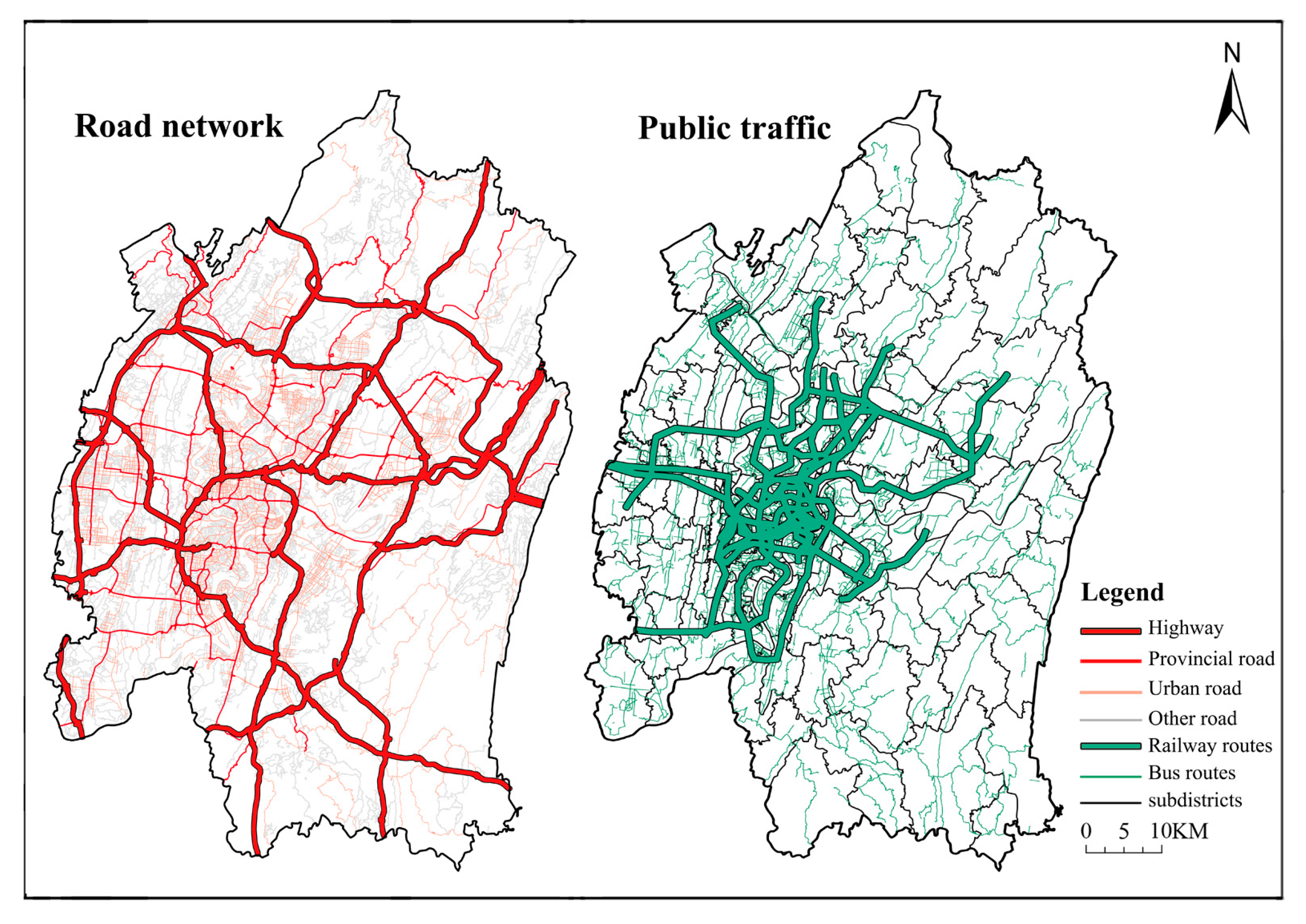


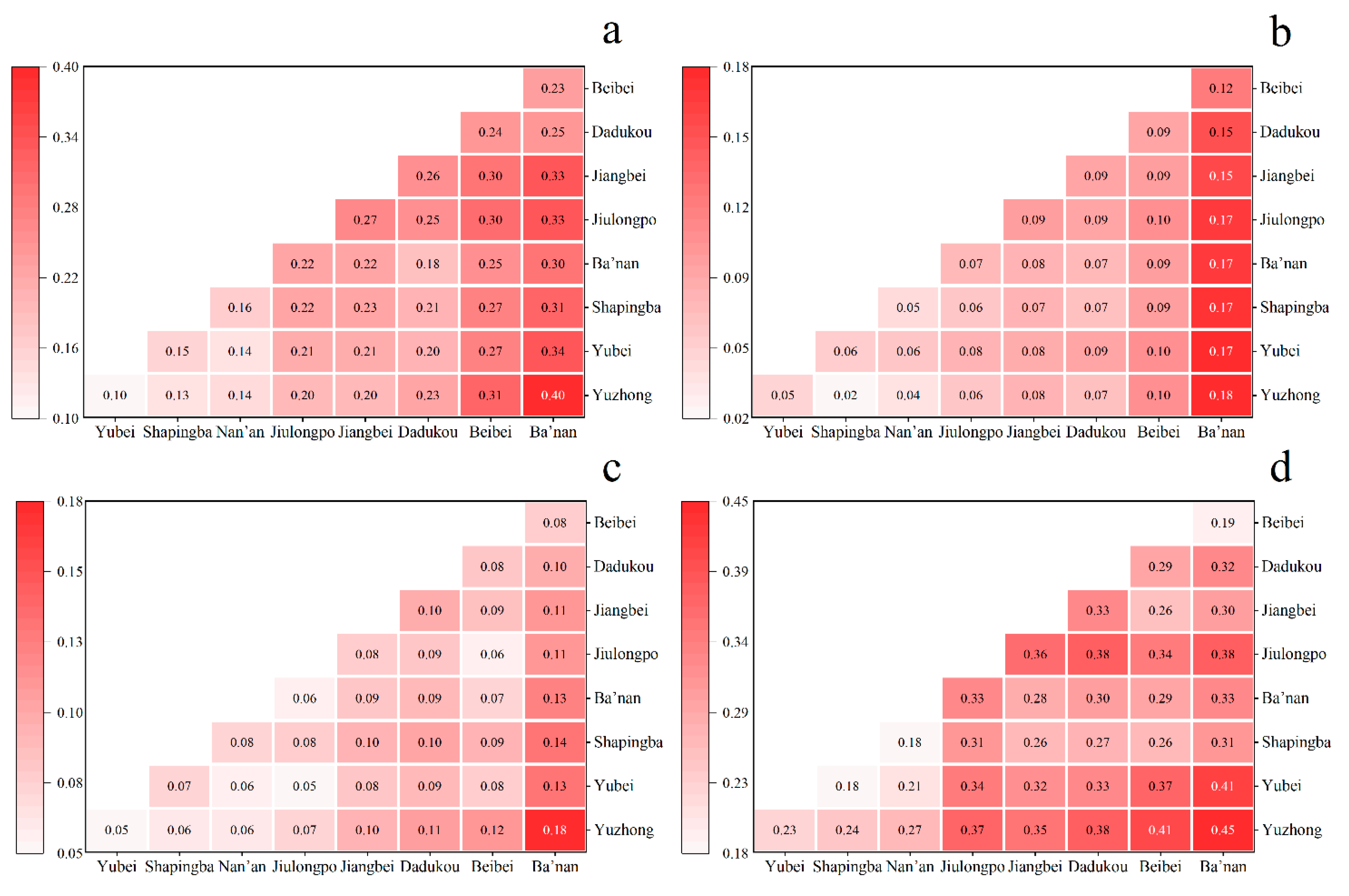
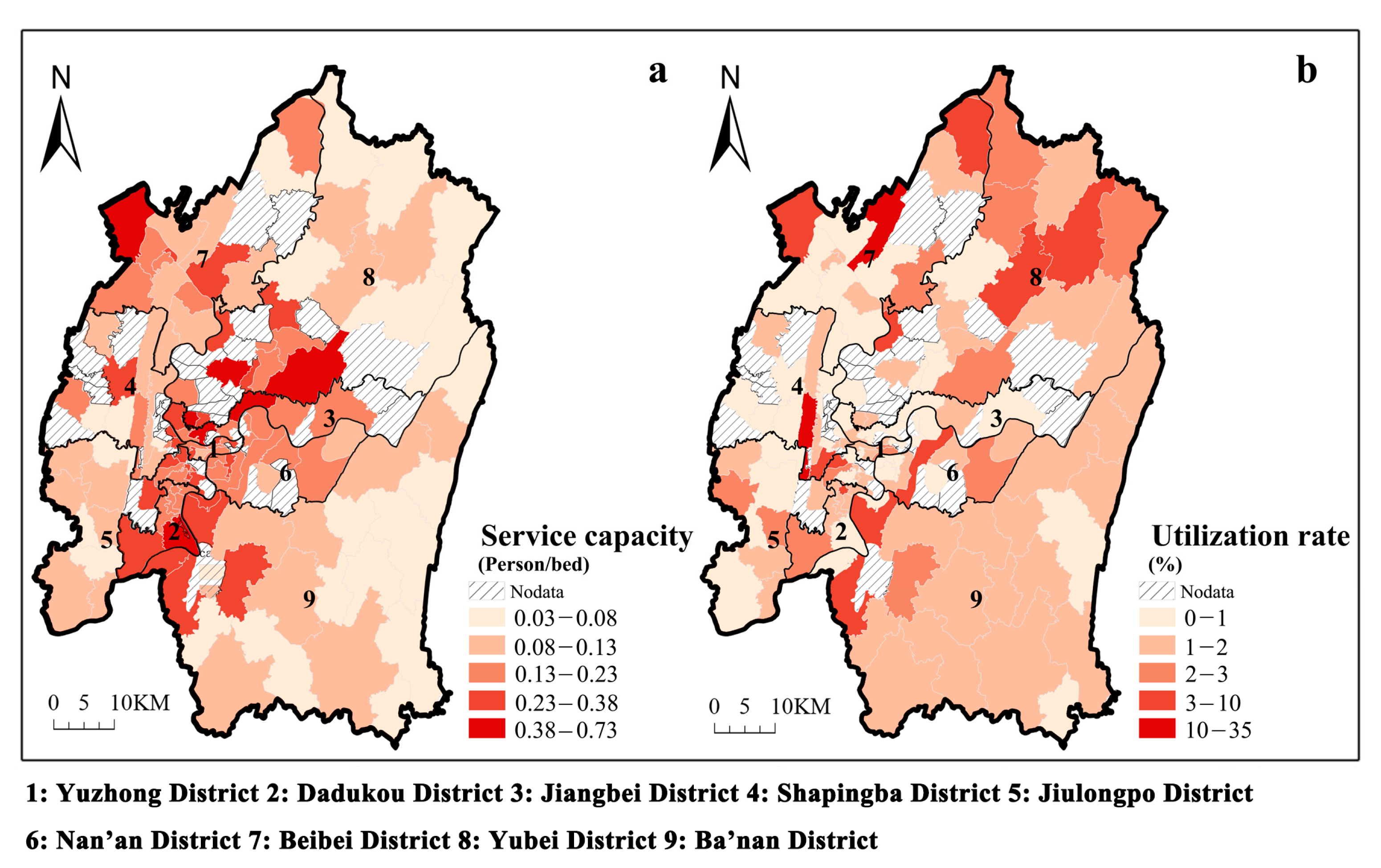
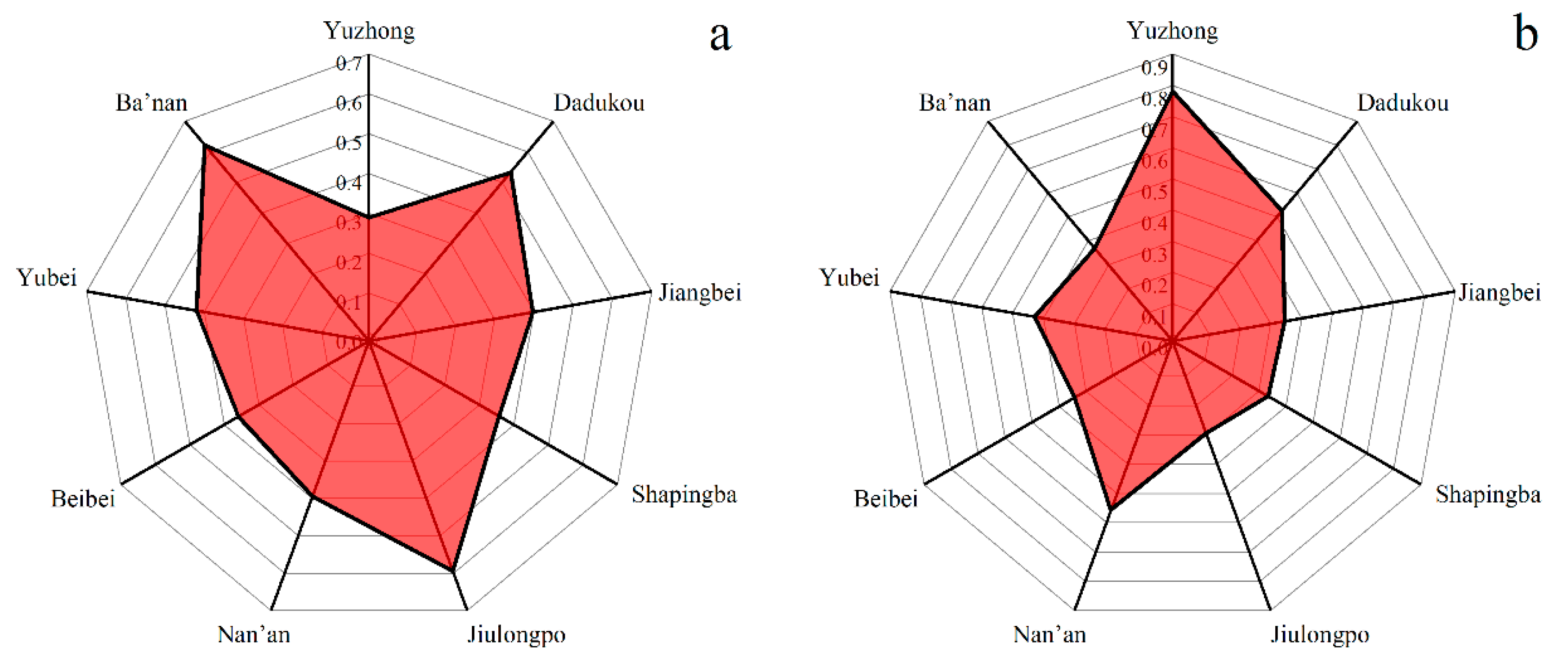
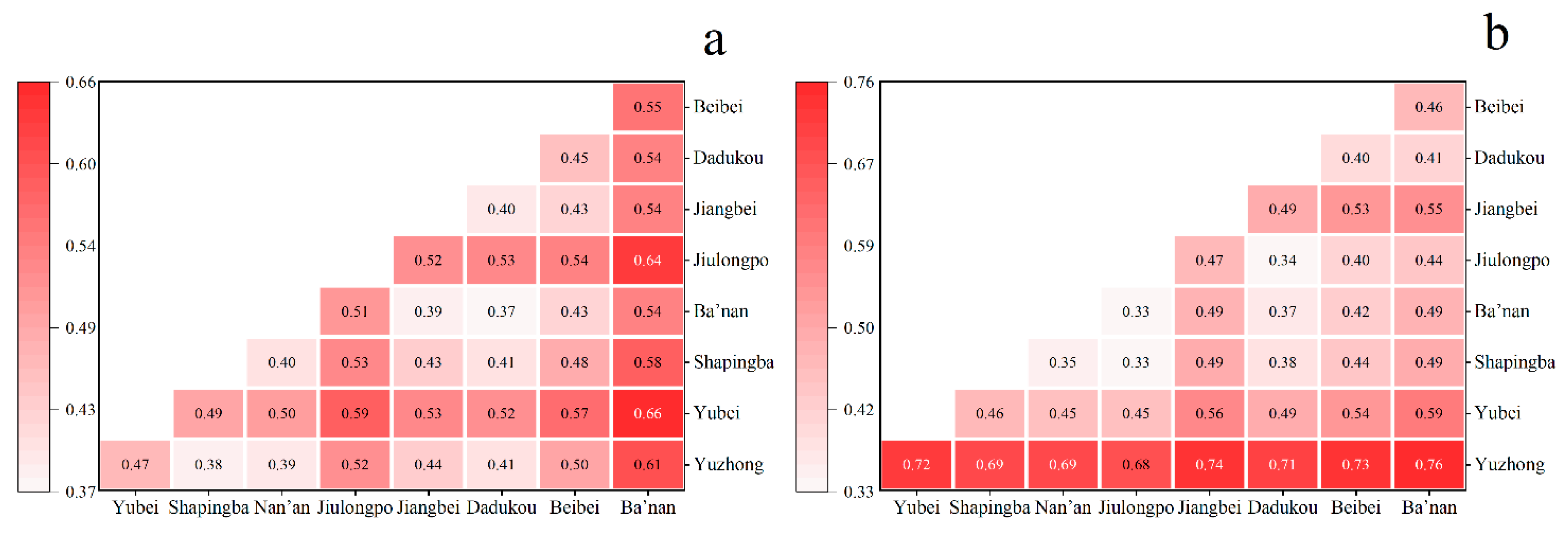
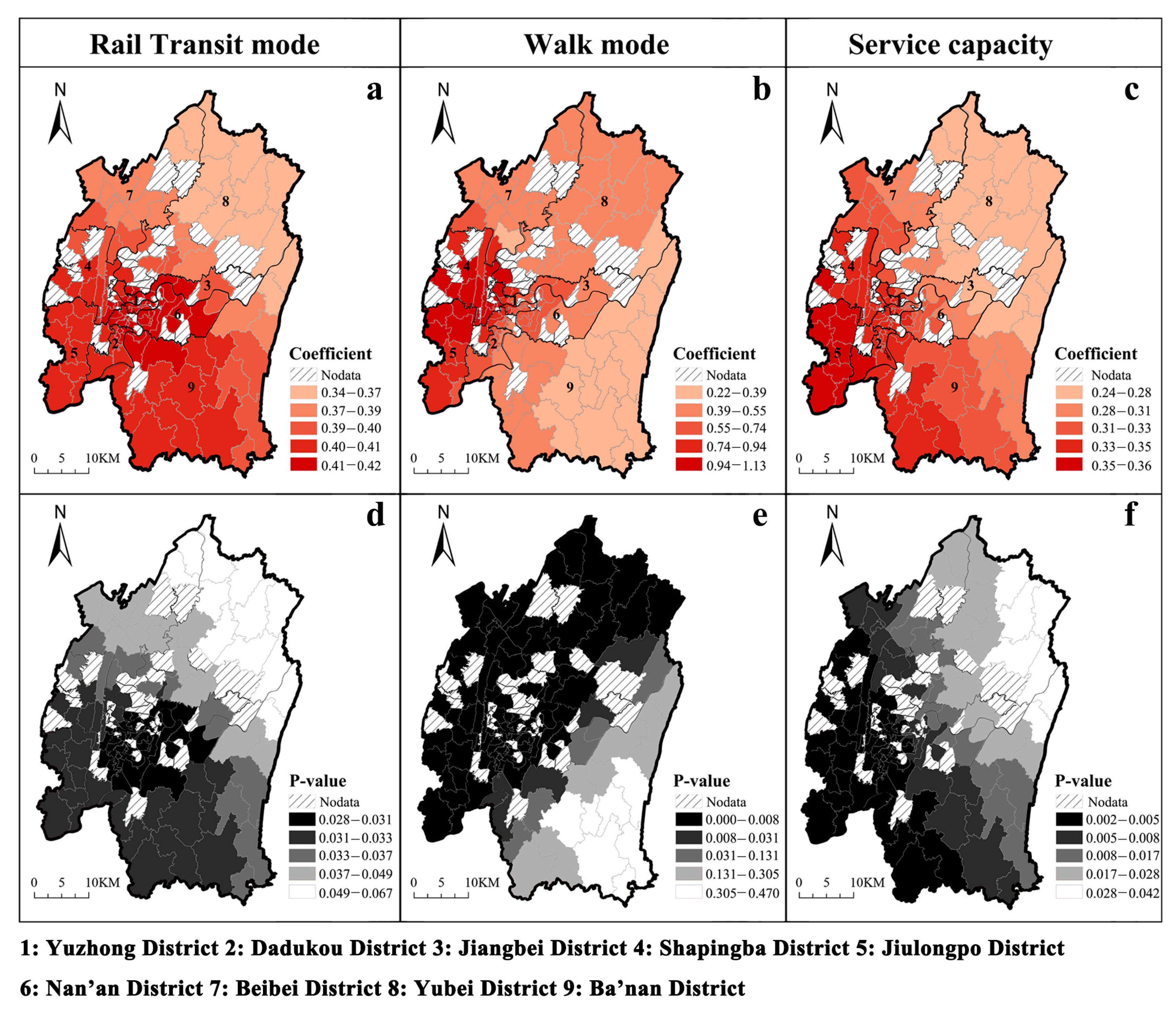
| District. | Area (km2) | Elderly Population (10,000 People) | Elderly-Care Facilities | |||
|---|---|---|---|---|---|---|
| No. of ECFs | No. of Occupants | No. of Care Staff | No. of Beds | |||
| Yuzhong | 22.89 | 11.63 | 25 | 983 | 312 | 1586 |
| Dadukou | 103.81 | 8.26 | 31 | 1325 | 475 | 2280 |
| Jiangbei | 222.22 | 17.64 | 15 | 911 | 353 | 1304 |
| Shapingba | 396.72 | 24.79 | 74 | 5552 | 1193 | 8546 |
| Jiulongpo | 431.31 | 27.60 | 37 | 2746 | 748 | 3982 |
| Nan’an | 262.44 | 21.64 | 37 | 2448 | 693 | 4298 |
| Beibei | 753.56 | 17.72 | 37 | 2031 | 613 | 3413 |
| Yubei | 1454.62 | 35.94 | 42 | 3479 | 1027 | 4951 |
| Ba’nan | 1820.02 | 25.73 | 58 | 4874 | 1715 | 7851 |
| Total | 5467.59 | 190.97 | 356 | 24,349 | 7129 | 38,211 |
| Travel Mode | Overall | Contribution Rates (%) | ||
|---|---|---|---|---|
| Gw | Gnb | Gt | ||
| Car | 0.10 | 10.54 | 57.18 | 32.28 |
| Subway | 0.09 | 10.04 | 54.25 | 35.71 |
| Bus | 0.23 | 10.23 | 52.30 | 37.47 |
| Walk | 0.31 | 11.42 | 44.80 | 43.78 |
| Type | Overall | Contribution Rates (%) | ||
|---|---|---|---|---|
| Gw | Gnb | Gt | ||
| Service capacity | 0.505 | 11.5665 | 29.2922 | 59.1414 |
| Utilization rate | 0.51092 | 11.5093 | 34.8646 | 53.6261 |
| Variable | Mean | STD | Min | Median | Max | p-Value | Adjust t-Value (95%) | t |
|---|---|---|---|---|---|---|---|---|
| Intercept | −0.04 | 0.02 | −0.07 | −0.05 | 0.02 | 1.00 | 2.11 | 0.00 |
| Rail transit accessibility | 0.40 | 0.02 | 0.34 | 0.41 | 0.42 | 0.02 | 2.13 | 2.29 |
| Car accessibility | −0.06 | 0.01 | −0.08 | −0.06 | −0.04 | 0.75 | 2.18 | 0.32 |
| Bus accessibility | −0.25 | 0.02 | −0.31 | −0.24 | −0.23 | 0.07 | 2.14 | −1.83 |
| Walking accessibility | 0.63 | 0.24 | 0.23 | 0.55 | 1.13 | 0.00 | 2.66 | 9.74 |
| Service capacity | 0.32 | 0.03 | 0.24 | 0.33 | 0.36 | 0.04 | 2.12 | 2.11 |
Disclaimer/Publisher’s Note: The statements, opinions and data contained in all publications are solely those of the individual author(s) and contributor(s) and not of MDPI and/or the editor(s). MDPI and/or the editor(s) disclaim responsibility for any injury to people or property resulting from any ideas, methods, instructions or products referred to in the content. |
© 2023 by the authors. Licensee MDPI, Basel, Switzerland. This article is an open access article distributed under the terms and conditions of the Creative Commons Attribution (CC BY) license (https://creativecommons.org/licenses/by/4.0/).
Share and Cite
Ma, J.; Huang, H.; Liu, D. Influences of Spatial Accessibility and Service Capacity on the Utilization of Elderly-Care Facilities: A Case Study of the Main Urban Area of Chongqing. Int. J. Environ. Res. Public Health 2023, 20, 4730. https://doi.org/10.3390/ijerph20064730
Ma J, Huang H, Liu D. Influences of Spatial Accessibility and Service Capacity on the Utilization of Elderly-Care Facilities: A Case Study of the Main Urban Area of Chongqing. International Journal of Environmental Research and Public Health. 2023; 20(6):4730. https://doi.org/10.3390/ijerph20064730
Chicago/Turabian StyleMa, Jinhui, Haijing Huang, and Daibin Liu. 2023. "Influences of Spatial Accessibility and Service Capacity on the Utilization of Elderly-Care Facilities: A Case Study of the Main Urban Area of Chongqing" International Journal of Environmental Research and Public Health 20, no. 6: 4730. https://doi.org/10.3390/ijerph20064730
APA StyleMa, J., Huang, H., & Liu, D. (2023). Influences of Spatial Accessibility and Service Capacity on the Utilization of Elderly-Care Facilities: A Case Study of the Main Urban Area of Chongqing. International Journal of Environmental Research and Public Health, 20(6), 4730. https://doi.org/10.3390/ijerph20064730




